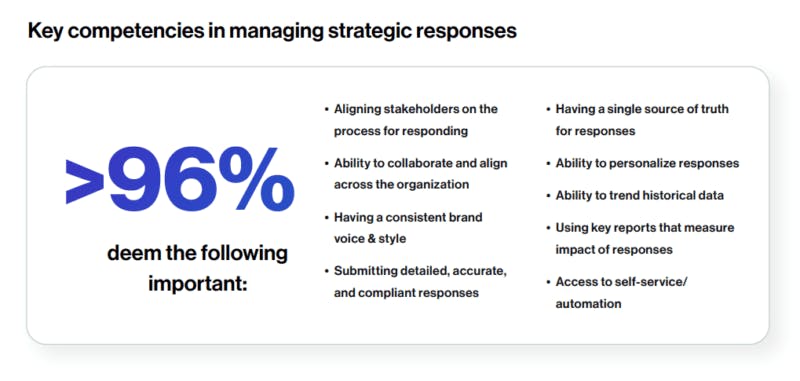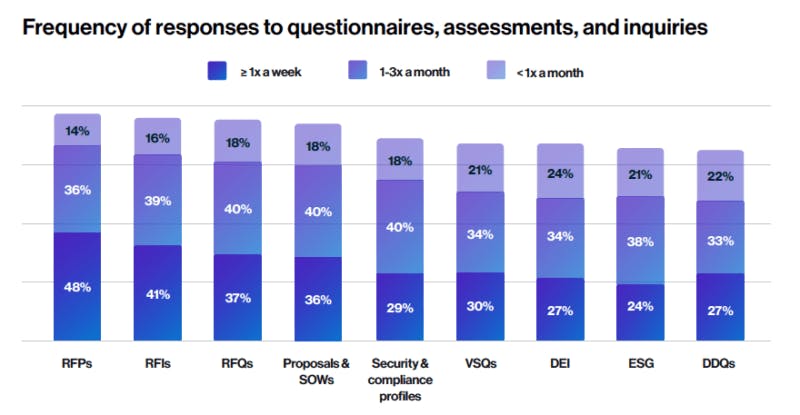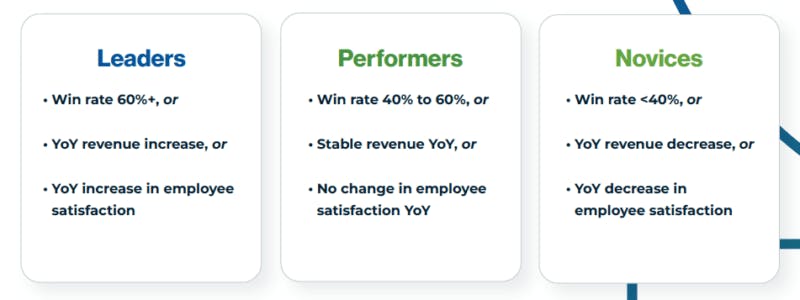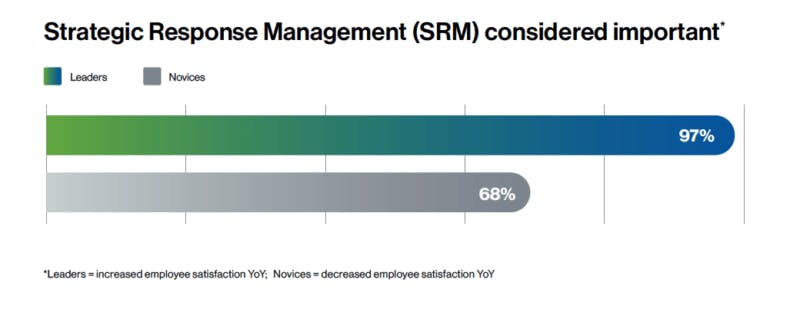B2B buyers today demand more information, on shorter timelines, and with tighter budgets. Competition has never been fiercer, so organizations have to respond faster, more accurately, and more persuasively to meet heightened buyer expectations and win the deal.
As a result, leading companies are embracing Strategic Response Management (SRM) — a modern approach to bid and proposal management that unlocks organizational knowledge and offers a competitive edge. Together with the Association of Proposal Management Professionals (APMP), Responsive recently published the 2024 State of Strategic Response Management Report: How Leading Companies Are Winning More, a landmark study that unveils industry benchmarks and reveals how winning companies are approaching SRM.
Data from over 750 sales, proposal, and IT executives and practitioners revealed what organizations are doing to gain a sharp competitive edge and how they’re driving sustainable, profitable growth through the implementation of a comprehensive SRM strategy and by embracing AI.
The full report is a must-read, but we know time is already short in the world of SRM, so we’ve compiled some of the most important highlights and actionable insights here.
Without further ado, let’s dive into the Strategic Response Management trends and data surfaced in the research. We’ll reveal what leading organizations are doing to stay ahead of buyer trends to deliver compelling responses and proposals that more business.
What is Strategic Response Management (SRM)?

Strategic Response Management (SRM) may be a new term to many, so it’s worth a brief aside before we dig into the trends. SRM is the people, practices, and technology that unlock organizational knowledge for profitable growth.
For business leaders, SRM serves as a critical bridge and operating ethos that democratizes organizational knowledge across all customer-facing teams, eliminating barriers to presenting compelling and compliant narratives that drive business growth through more wins and increased revenue.
For proposal professionals, SRM represents an opportunity to grow their impact on revenue operations as they leverage powerful AI platforms, advanced analytics, and cross-functional collaboration to become the future leaders in the C-suite.
Buyer scrutiny is on the rise — and so is the pressure on proposal teams
It’s never been harder to win. B2B organizations are facing more stringent requirements today as buyers become more exacting and specific in the type of information they seek throughout the purchasing cycle (and across the lifespan of a relationship).
According to the survey respondents, these include:
- An increase in requirements from buyers (48%)
- Tighter budgets (47%)
- Buyers’ desire for platform-based solutions (45%)
- Buyer expectations for faster response times (45%)
Without the adoption of SRM, companies are struggling to respond to the growing volume of information requests that now encompass far more than traditional bids. Put simply, most organizations aren’t equipped to handle this increased volume and complexity.
Why? A lack of effective knowledge management and siloed organization charts that isolate bid and proposal teams. This is especially harmful as these same teams are driving one of the most strategic, revenue-generating functions in an enterprise.
In fact, the research found that 48% of company revenue is tied to RFPs, bids, tenders, and proposals. Additionally, 70% of companies reported an annual increase in revenue generated through RFPs and other strategic responses.
However, nearly a third of the responses in the report said the challenges above are negatively impacting win rates and deal volume. What can you do to counter this?
Organizations need to embrace the idea of SRM to unify their teams, centralize their content, and democratize their knowledge. Now is the time to recognize and elevate bid and proposal teams, which are at the very core of SRM, and empower them to function at maximum capacity.Rick Harris, Chief Executive Officer, APMP
The research from The 2024 State of Strategic Response Management Report reveals that companies that understand this and invest accordingly win more deals and generate more revenue. They also improve operational efficiency and employee satisfaction across the board. Keep reading for the specifics.
The unsung heroes who propel growth
Bid and proposal teams often report that they feel like “the unsung heroes propelling growth,” working behind the scenes to power their organization’s revenue engine. Their impact is essential, but the research revealed that this is often not reflected in how they’re viewed from the top.
“Historically, proposal teams have been seen as cost centers, but this is outdated,” said Danelle Morrow, CF. APMP, VP North America Proposal Development Center at Sodexo. “The reality is that proposal teams are strategic response teams that align cross-functional stakeholders, processes, and systems.”
In an interview featured in The 2024 State of Strategic Response Management Report, Morrow details how she made a business case for her function and lobbied for additional resources — just weeks after joining Sodexo and learning that her CFO planned to cut her budget by 80%.
“This transformation would not be possible if the numbers didn’t move with us, and we have the results to show for all our work, including a steady, double-digit increase in win rates, doubling stakeholder CSAT scores, and more mega deals won than any prior year,” Morrow said.
It’s an excellent case for bid and proposal teams, but not every team sees the same recognition at their company, even if the leadership team knows their value.
The report highlights the discrepancy in perception between executives and practitioners:
- 90% of executives consider bid and proposal teams visible, vital strategic partners
- 85% of executives said their bid and proposal teams are well-resourced
- Yet, only 65% of practitioners feel like well-known business partners across their organization
- 52% of practitioners are highly satisfied at work
There’s a general agreement on the vital role bid and proposal teams play in revenue generation, and yet, leadership is still largely unaware that these teams feel under-resourced and undervalued.
As organizations field more questionnaires, assessments, and inquiries, bid and proposal teams have become significantly more strained in overseeing responses and surfaced a number of significant challenges.
Nearly 50% of organizations surveyed said they respond to lengthy RFPs at least once a week. RFIs ranked second highest at 41% with DDQs at 27% as the least common to respond to at least once a week for other types of questionnaires, assessments, and inquiries.

However, the increase in volume of questionnaires, assessments, and inquiries is far from the only challenge bid and proposal teams face. The most significant challenges proposal teams face (according to all survey respondents) include:
- 50% have too few resources to effectively handle the volume of requests
- 49% face tight deadlines
- 48% have difficulty getting input from multiple subject matter experts (SMEs)
- 46% face an overwhelming volume of siloed and scattered information
- 41% find difficulty in identifying the right requirements and/or contributors
Creating an effective solution to these challenges requires a fluid process that brings together the right subject matter experts (SMEs) and stakeholders to democratize knowledge across the company so all information shared is current, compelling, and compliant.
Let’s take a look at how some of the leading companies are doing exactly that.
Insights from companies using Strategic Response Management (SRM) to win more
The business climate is challenging as these invaluable bid and proposal teams face increased pressure and tighter deadlines. And with almost half of all company revenue attributed to strategic responses, there’s a great deal at risk.
Companies now have a simple choice: be crushed by the increased demand or crush their strategic responses by driving optimal SRM across the organization.
Data in the report reveals that companies that embrace the idea of SRM and harness the power of AI win more deals, generate more revenue, and have greater employee satisfaction. To surface how leading companies are gaining an edge, organizations responding to the survey were categorized into three categories: Leaders, Performers, and Novices.
Leaders saw the largest win rate, revenue, or employee satisfaction increase on a YoY basis. Novices saw the lowest increase in win rate, or they saw a decrease in revenue or employee satisfaction. Performers were somewhere in the middle.

So, what were these response Leaders doing differently? The research found three important differences:
- Recognizing strategic response teams as high-impact players
- Investing in resources to help grow these teams
- Designing scalable processes that unify their teams
Recognizing strategic response teams as high-impact players
Leaders view bid and proposal teams as more than just strategic partners — the companies with the highest win rates exemplify a synergistic relationship between the C-suite and bid and proposal teams. Leadership at these organizations are intertwined with the work that strategic response teams do.
When asked why, Leaders said the C-Suite has expertise that everyone in the organization should access and use (63%), executives’ contributions impact win rates (57%), and executives’ contributions accelerate company growth (55%).
Compared to Novices, Leaders also said their strategic response teams are far more likely to contribute to and help shape the company’s go-to-market (GTM) strategy (85% vs. 65%).
Investing in resources to help grow these teams
The data from the study revealed that companies that saw the greatest success were those that invested resources into their bid and proposal teams across technology, training, and budget.
Nearly one in four (24%) of the companies that saw a decrease in revenue YoY say that their top proposal challenge is that they have too few resources to effectively handle the volume of requests. In contrast, only 10% of Leaders said it was their top challenge.
Companies with higher win rates are also far more likely to be using data and analytics from response systems to improve processes and increase win rates – 80% for Leaders compared to 61% for Novices.
Designing scalable processes that unify their teams

Finally, the report revealed that Leaders place significant importance on SRM within their organizations.
97% of companies that reported an increase in employee satisfaction for those involved in response processes (Leaders) consider SRM important to their business, compared to 68% of companies that saw a decrease in employee satisfaction YoY (Novices).
As we outlined earlier, SRM involves people, practices, and technology coming together cohesively to leverage company knowledge for profitable growth. Collectively, the report shows that a greater investment in and activation around SRM leads to higher win rates, increased revenue, and a better overall employee experience.
Together with a comprehensive AI strategy, SRM has been, and will continue to be, crucial in managing the rapid growth of proposal volume by providing bid and proposal teams with a scalable solution that supports teams of all sizes.
See more industry insights in the 2024 State of SRM Report
While we covered how and what leading organizations are doing to stay ahead of buyer trends with effective SRM strategies, the complete 2024 State of Strategic Response Management (SRM) Report goes into far deeper detail than we could here.
Grab a copy of the free report to dive deeper into a slate of topics, including:
- Responding to escalating buyer demands and stakes with an effective SRM strategy
- Demonstrating value as bid and proposal teams
- Why Generative AI is not an effective AI strategy on its own
- Pro tips and insights from industry luminaries
- Actionable strategies you can immediately employ to unlock faster growth
Interested in reading more? Access the full 2024 State of Strategic Response Management (SRM) Report to see all the data that will undoubtedly prove essential in shaping a winning SRM strategy.

